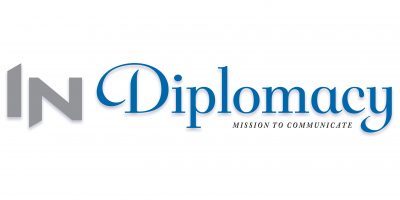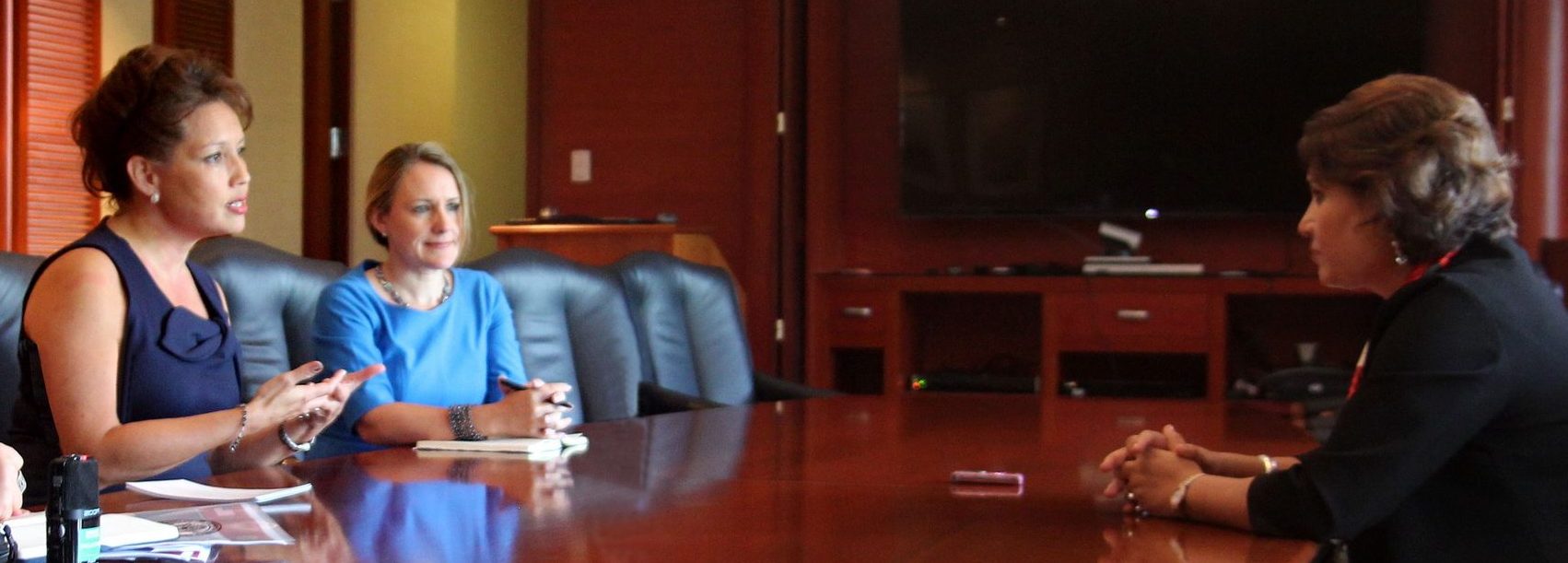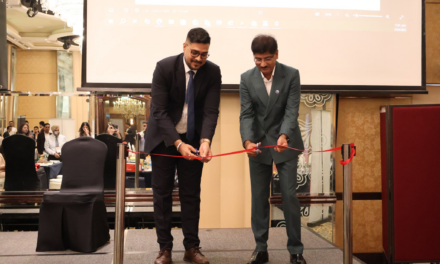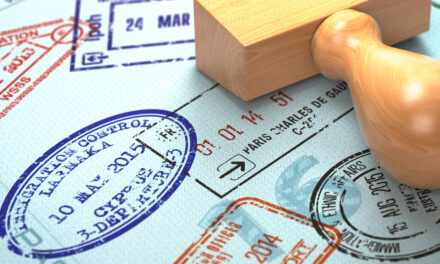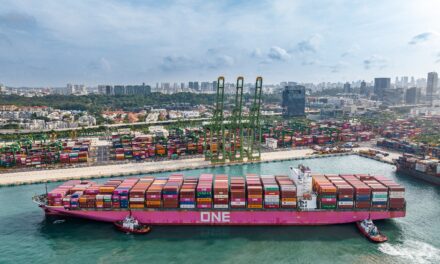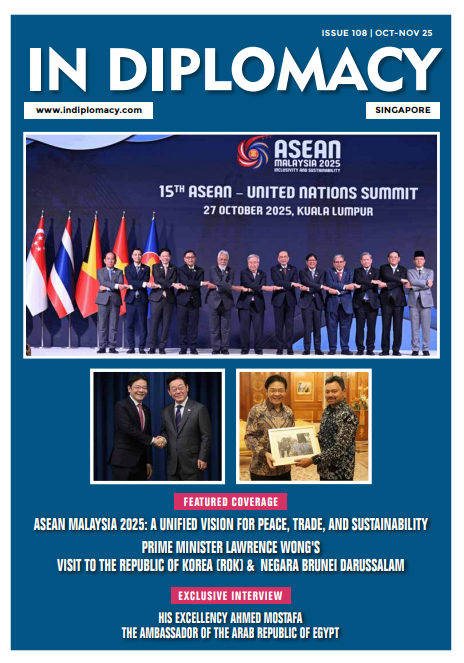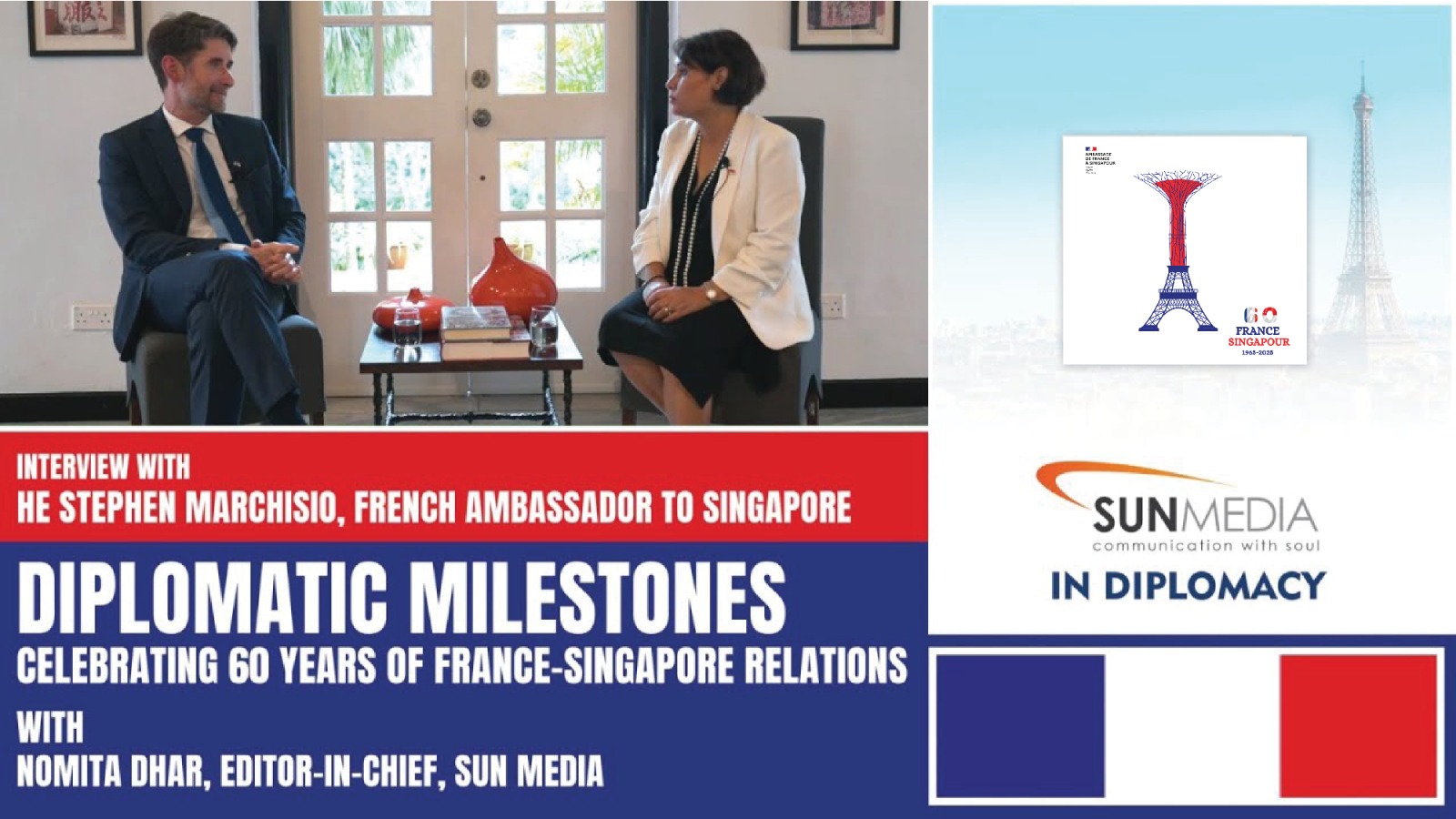U.S. Embassy Singapore Chargé d’Affaires (CDA) Stephanie Syptak-Ramnath in a wide ranging conversation with Editor-in- Chief Ms Nomita Dhar, offer readers of IN Diplomacy an insight into the multiple layers which comprise this highly important, deeply committed and incredibly vibrant relationship between the two countries which dates back to half a century
Good afternoon your Excellency. It’s an honour to talk to you for our first print edition of IN Diplomacy.
Congratulations on the new venture, which is very exciting. Thank you very much for allowing me to be part of your new endeavor.
You have been in Singapore for two years now. How has your journey been so far?
It’s been a very exciting time being here, not only with the change in administration, but also because of the great work we are continuing to do with Singapore. The world events that have happened here have allowed us to work very closely with the Singaporeans to advance the cause of peace and prosperity in the region.
President Trump’s visit to Singapore was the highpoint of things that have happened in 2018. The whole world was watching and your office was doing the bulk of the work. We saw on camera what took place but please share what was happening behind the scenes and what it took to make it happen?
If you remember, we didn’t have much time to plan the Summit. I think between the announcement and the actual June 12 date we had just about four weeks. You’ll also remember that in the middle of that we had the Shangri-La Dialogue, which in itself is a very important and busy moment for Singapore, for the region, and for the United States. My incredible staff was working very closely with the White House advance team and the Singaporean government to take care of the logistical requirements of welcoming two heads of state to Singapore and ensuring that we had the setting right for an important conversation to take place.
What went into choosing Singapore as the venue?
A number of things I would say. First and foremost, the long-standing partnership between Singapore and the United States that we have built over 50 years and the great trust and confidence we have as partners to work very well and in full transparency together towards a common goal. So that was part of it. The other was security, which was of prime importance in ensuring that both leaders had a productive meeting in the country. We know that Singapore excels in terms of being able to work with its citizens to ensure they can manage all the different aspects of large events that go into providing security for leaders coming here. There is also the efficiency that is needed to get everything ready – to make sure that hotels are arranged, that the venue site is taken care of and all the tiny details that go into it, whether it was welcoming President Trump or Chairman Kim, from the very moment they landed to the time they left— and everything in between.
There were a lot of security details to be arranged and Singapore with its well-known efficiency, and practicality, have a knack for seeing what needs to be done and just getting it done. They were the perfect partner for us for this meeting, as we took on something that had never happened before. I think the other big part was the number of journalists who were here. Singapore’s International Media Centre had 2,000 international journalists. The White House had over 350 travelling press, and the South Koreans brought around 500. So you can imagine that managing all the logistics for that number of journalists required good partnership between our embassy and the Ministry of Communication. These are some of the details of which people were probably not aware when the handshake was going on, because it was all behind the scenes.
Regarding the bilateral ties, you have engagements with the United States in Singapore on multiple levels, please brief us on what’s happening and what to expect.
As you may know, with over 50 years of partnership we collaborate across almost every sector you can imagine. Of course, we have very deep commercial and economic relations that actually pre-date even our government-to-government relationship. American businesses have been working in this region since the 19th century. Even our first Consul Joseph Balestier was here working on business issues. We have 4,200 U.S. companies in Singapore, many of them are using it as a base for the region as well. That number has increased by 10 percent in the two years I have been here. So you can see Singapore and ASEAN will continue to draw American businesses here to see what we can achieve in a fairly dynamic region. So that’s an important part of the work that we do. There’s also the security aspect. We, of course have a very strong military partnership which continues to grow in complexity and ties. We are also collaborating on many law enforcement issues, whether financial crimes, white collar crimes, cyber security, or counter terrorism. There are a wide variety of high level issues that the U.S. and Singapore work on together. Singapore is the gateway to the region and, as the largest transshipment port in the world and with one of the busiest airports. Singapore is watching a lot of things with a careful eye. We work with them on those kinds of border security and counter-proliferation issues as well.
And then of course the third aspect is that we are continuing to build the very strong people-to-people ties that have made this relationship what it is. We have enjoyed a very close partnership, I would say friendship, with Singapore since its independence and we continue to look to grow these relationships, because fundamentally it is the personal connection that makes everything possible.
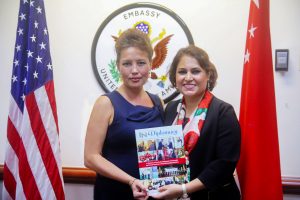
What do you think are the similarities between the .U.S. and Singapore in terms of governance or in terms of people-to-people, in terms of hearts?
I think we are both very practical in our approach in that, again, we are able to define clear objectives and work towards them. We also have a deep respect for transparency and rule of law and that is fundamentally an issue that ties us together, especially from a commercial standpoint, but also from a security standpoint. Our companies feel comfortable investing in Singapore and moving to Singapore, because it has a whole infrastructure of rule of law with arbitration and with transparency, anti-corruption and just a way of doing business here which resonates with the American way of doing business. Additionally I think both our countries value education and the possibility that education brings in a meritocracy. We believe that people can be born into any situation but they can become whomever or whatever they want to be by working hard to get there. That’s another very important characteristic that we share. And finally, a respect for diversity. A respect that a country can be made up of all kinds of ethnicities, religions and points of view, but together we can succeed by respecting one another and giving each other a chance to be who we are and to truly belong.
Returning to the subject of education again, there are a lot of students from Singapore who go to study in the U.S. How do you engage this segment of society? Also what about American students who come here to Singapore on exchange programmes?
We think it’s very important to focus on the future and future generations of leaders. So when it comes to academic exchange we have a little more than 8,000 Singaporean students studying in the United States every year. Singaporeans are attracted by quality education and fortunately United States higher ed institutions are often at the very top of the lists of the best universities in the world. So that’s a large draw for Singaporeans to go to say California, Massachusetts, Illinois and other states. So in a sense it’s fertile ground because so many Singaporeans are aware of the great universities that exist in the U.S. At the same time we can’t take this for granted because there are other great universities around the world as well. So we continue to focus on advising students,. Students and their parents can go and learn about the possibilities of education in the United States free of charge at the EducationUSA advising center at Stamford American School. We may already have about 8,000 students from Singapore in the United States, but we would like to welcome even more.
There are also Americans who come to Singapore on exchange programmes, right?
Yes. We have a very exciting exchange programme run by Singapore’sMinistry of Foreign Affairs and supported by American companies called the US-SG Summer Scholarship Exchange Programme. This program will bring 50 Americans to Singapore for summer exchanges over five years and send 50 Singaporeans to the United States. We also have American students and scholars coming through the Fulbright and Gilman scholarship programs. What’s very interesting about the American students coming to Singapore to study is the variety of students from many different universities and backgrounds, including the naval academy, which sends midshipmen here for a semester.
So really the ties are quite astonishingly varied and deep. Again, as students look to study overseas, and in this region, I think Singapore is a natural choice because because of the quality of education and the fact that studies are done in English.
How many Americans are there here in Singapore and how do you engage with them?
We have a little over 30,000 Americans on any given day in Singapore. There are a variety ways in which we interact with the American community here.
First, there is a large military population. We work very closely with the Admiral who is in charge of the military personnel here to make sure we are supporting each other and are in constant contact. We work very closely with the American business community through the American Chamber of Commerce. Then there are a variety of other organizations with whom we work. There is a great book called “The American Journey in Singapore” by Jim Baker, which traces the history of America and Singapore starting with the very first traders to arrive to the region. The American Association of Singapore just celebrated its centennial last year. That was the first organization that was started here in the early 20th century to take care of American citizens. Out of the American Association of Singapore grew the American Club, which was the first club here to be open to all ethnicities in the 1960s. There’s also the American Women’s Association, the American Dragon Boat team and the Navy League as well as Boy Scouts and Girl Scouts. There are lots of ways in which the U.S. Embassy supports the American community. The most important thing, of course, is our consular section, which provides support to American citizens for both routine and emergency services. That is one of the most important functions in any embassy.
I believe there are about 14 government departments who are in Singapore are under you. Is that right?
There are 19!
How do you manage them?
I have an incredible team.. I must say the quality of individuals that we are able to attract to work here at the United States Embassy in Singapore is really top notch, regardless of what agency we are talking about.. About 40 percent of my staff has regional responsibilities based out of Singapore. We have such a wide array of agencies and they all give their best at work. It makes my job much easier, because I have such a strong team which really works very collaboratively and very closely with our Singaporean counterparts to figure out the best way to take things forward.
You have started your work for the forthcoming summit in November. What is expected from it?
The U.S. delegation will get to meet counterparts from the region and to look at the many challenges and opportunities that exist in terms of this diverse region which is so vibrant and where so many young people are waiting to become more prosperous and to embrace the opportunities that await us. We want to work with our partners to ensure that we are really doing everything we can to advance the strategy of a free and open Indo-Pacific where peace and prosperity exists and each country has the space to be able to develop and make their own decisions for the future of their citizens. That is what the U.S. wants for the region.
This year Singapore holds the Chair for ASEAN. So you are having a lot of high level visits?
Yes. It’s an honour to welcome senior officials from the President to Vice President to our multiple cabinet officials and Congressional Representatives. They are coming to Singapore this year because it’s very important to engage with the region. There are many ways in which we work to support ASEAN and most of these are ongoing initiatives. . But this year there are some particular programs to highlight. We first have the Young South East Asian Leadership Initiative (YSEALI)—that’s a programme which launched in 2013 and brings together young leaders from across ASEAN to build their capacity and also to encourage them to work together on regional issues. We are very excited that in December we will host the annual YSEALI Summit here in Singapore.
We also have the Third Country Training Programme— a joint programme run by Singapore’s Ministry of Foreign Affairs and the U.S. Department of State which has trained more than 1,000 government officials across ASEAN. Since 2012 have held 47 courses on a variety of issues, from cybersecurity to disease outbreak response to e-commerce. It really covers a very wide range of issues.
The third exciting initiative to mentionis our support of the ASEAN Smart Cities Network (ASCN).That’s another programme where we are working directly with the Singaporean government and American companies to engage with partners throughout ASEAN,
Did you have a big Smart City delegation here?
We had a delegation from Colorado and one from Hawaii. Because of the federal nature of the U.S. government, smart cities actually fit within states, it’s not a federal level office. So, we have had multiple state delegations. Multiple cities are interested in seeing how they can work with Singapore and what they can learn from Singapore. Our Foreign Commercial Service office works very closely with the American business community to create synergies there and they just announced two partnerships— Wiley &Sons, who do all the ‘Dummies’ books have agreed to support a city in Indonesia and IBM has signed an agreement for the ASEAN Smart City Network. Other American companies are also involved in this initiative.
For big companies to start marketing or relocating or even start a business in the U.S., it looks quite easy. But for small and medium size enterprises it’s a struggle. What would you like to say to Singaporean companies to invite them to do business in the U.S.?
The United States is open for business and Singapore is our 18th largest trading partner. Singapore, compared to other places in the world, has a very good structure to help their SMEs in the United States through the different offices they have set up—EDB and others, to help their companies succeed. We agree that our future is in SMEs. We are very happy to have companies like We Work come to Singapore and find the synergies that exist to work with their counterparts and find way to bring those investments back to the United States. I think the digital economy is also opening up new avenues for SMEs that they may not have had otherwise.
Our Foreign Commercial Service does a lot to take trade delegations to our major cities in the United States to show them the possibilities. I would say that any company that is interested in doing business in the U.S. can contact our Foreign Commercial Service office at the embassy.
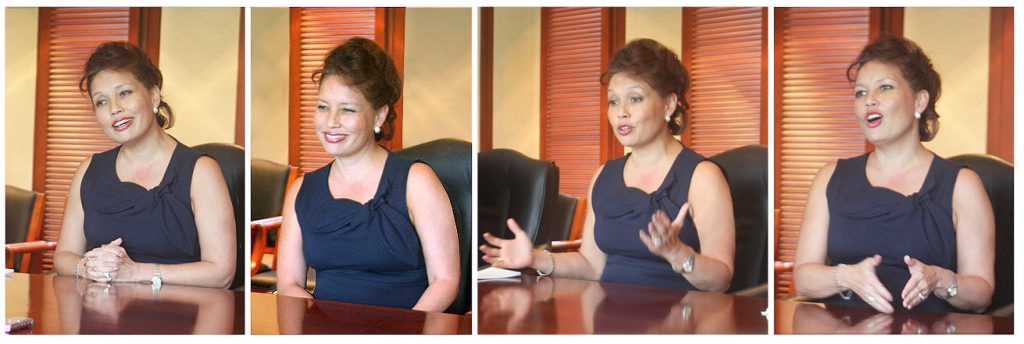
Tell us about something about yourself. Your CV is fascinating as you’ve been all over. What’s especially intriguing is your naval background.
My mother was actually from Singapore. My father was a fighter pilot in Vietnam. They both met here in Singapore in the ‘60s. They’ve been married for over 50 years. I didn’t grow up here however because they moved back to the United States. But they say you cannot take Singapore out of the Singaporean, and so much about the culture feels like home to me. My mother is a very good product of Singapore— she has high expectations and graciousness and gracefulness. I’m very proud of her. I grew up on military bases because my dad was in the military. So it was very natural for me when I was going to university to go on a military scholarship. I went to Georgetown University, but on a Navy scholarship, which meant that in addition to my normal course load, I also studied celestial navigation and other military courses, and I spent summers on a naval ship. When I graduated, I was immediately commissioned into the US Navy and spent two years with a squadron in Guam.
I was also in Washington DC for three years where I worked on personnel programmes for the Navy. At the same time I was going to law school at night. I thought I would be a military lawyer, otherwise known as a Judge Advocate General or JAG. But I had also taken the Foreign Service exam in university. When they called and asked, “Are you ready to join?” I thought, I can always go back to law school…or join the military, but I don’t think I will be offered the chance to be a diplomat again. So I left the navy on a Friday and on Monday I joined the Foreign Service. That was 22 years ago.
So which is the best segment of your life? The navy or what you do now?
I can’t choose between one or the other. It’s a continuum of blessings. Every experience I have had has made me know the world better, know myself better. And I’ve tried to understand how I can better represent the American people, and how I can make the world a better place for America and the world’s citizens.
You’ve also done a course on women leadership?
Yes. It was run by the International Women’s Foundation (IWF), a well- known international organization. They have a fellowship programme where they identify top women leaders and bring them together. There were about 25 of us from Africa, Europe, China, etc. We spent a week at Harvard, and a week here at INSEAD in Singapore. It was fascinating on various levels. For one, it was wonderful to step back from work, which I think is very important. It was fascinating to be with women from the private sector because I think we share some challenges, but some challenges are quite distinct depending on what industry you are working in.
It was a great experience to understand not only the situation of women in government in the United States or women in the United States, but women around the world, and how best we can work in whatever place we are to advance, not just the issues of women, but advance human issues. And that’s another thing I’d like to talk about, I found there were so many issues that are not gender-specific. Everyone wants work-life balance— to have a family or to take care of ageing parents if they need to. It’s really much more than women’s issues; it’s how we encourage our employees to be whole people so they can be great at work.
Are we there yet…to create an equal world? What can we —the U.S. and Singapore collaborate on to get these issues addressed?
There will always be work for sure. But I think the U.S. and Singapore have an aspirational view of what the world should be like…of the diversity that should be respected and accepted, the rule of law that should provide a level playing field for everyone who is interested…whether it’s investing in a country or applying to a university… I think it’s also about continuing to promote those values, not only in how we live our own lives and govern ourselves, but also how we encourage those who work with us also, to embrace those values and standards. And I think it is something we can do every day to move the world in the right direction.
Which are your favourite places in Singapore?
There are so many. Gardens by the Bay, China Town, Arab Street. I love the bird singing corner at Ang Mo Kio, which represents one of the few traditional pastimes still observed.
If you were to replicate something of Singapore in any of the states in America what would it be?
Singapore’s respect for the rule of law and the belief in a citizen’s responsibility to one’s country, whether it’s not throwing trash on the ground, or voting, or obeying traffic rules. I think that is fundamental to any progressive society. The government is expected to look after its citizens, but citizens too have a responsibility to contribute to the success of their country. This is something I would say should be replicated from Singapore, not just in the U.S. but around the world.
How relevant is diplomacy today, it’s not always the first choice of students as a career path?
I think diplomacy is a good career choice because; there will always be some new issue that we have to work on together, whether with new partners or traditional partners in different regional groupings. But I would also argue that diplomacy is fundamental to whatever you do, whether you are in business or are a teacher or an athlete…whatever you do, the personal connections that you develop and nurture can make you successful. Diplomacy more than anything else is about making connections so that individuals can see eye to eye…and if they don’t see eye to eye they can find a way to work together toward what they do share in common. Diplomacy is something we have to exercise every single day no matter what our job may be.
